Abstract
Context:
According to the attention restoration theory, directed attention is a limited physiological resource and is susceptible to fatigue by overuse. Natural environments are a healthy resource, which allows and promotes the restoration of individuals within it from their state of directed attention fatigue. This process is called the environmental restoration on individuals, and it is affected both positively and negatively by environmental factors.
Aims:
By considering the relationship among the three components of soundscape, that is, people, sound and the environment, this study aims to explore the effects of soundscape on the environmental restoration in urban natural environments.
Materials and Methods:
A field experiment was conducted with 70 participants (four groups) in an urban natural environment (Shenyang, China). Directed attention was first depleted with a 50-min ‘consumption’ phase, followed by a baseline measurement of attention level. Three groups then engaged in 40 min of restoration in the respective environments with similar visual surroundings but with different sounds present, after which attention levels were re-tested. The fourth group did not undergo restoration and was immediately re-tested. The difference between the two test scores, corrected for the practice effect, represents the attention restoration of individuals exposed to the respective environments.
Statistical Analysis Used:
An analysis of variance was performed, demonstrating that the differences between the mean values for each group were statistically significant [sig. = 0.027 (<0.050)].
Results:
The results showed that the mean values (confidence interval of 95%) of each group are as follows: ‘natural sounds group’ (8.4), ‘traffic sounds group’ (2.4) and ‘machine sounds group’ (−1.8).
Conclusion:
It can be concluded that (1) urban natural environments, with natural sounds, have a positive effect on the restoration of an individuals’ attention and (2) the presence of different types of sounds has significantly divergent effects on the environmental restoration.
Keywords: Attention level test, attention restoration theory, effect of soundscape, environmental restoration, field experiment
Introduction
With rapid urbanisation and overcrowding, the high stress and rapid pace of city life has caused mental and physical exhaustion of the urban residents, which requires restoration. In environmental psychology, restoration is defined as ‘the process of renewing or recovering physical, psychological and social capacities that have become depleted in meeting ordinary adaptation demands’.[1]
According to the attention restoration theory (ART) by Kaplan and Kaplan,[2,3] restorative environments allow and promote the restoration of people from the state of directed attention fatigue. Directed attention is a kind of voluntary attention, which plays a central role when an individual is focusing on cognitive tasks requiring effort to avoid distractions.[4] It is a limited physiological resource and is susceptible to depletion by overuse.[4,5] ART suggests that people cannot maintain clear cognition when their attention is exhausted, which will result in the reduction of mental efficiency and depressed mood.[2,3,6] Under these circumstances, if an individual is placed in such an environment that provides ‘fascination’, ‘extent’ and ‘compatibility’ and can give a sense of ‘being away’ from mental tasks that cause fatigue for a period of time, their directed attention capacity would be restored to a certain extent.[3,6,7] A number of studies have confirmed that exposure to natural settings can provide more effective restorative experiences than exposure to artificial urban settings.[8,9,10,11,12] The types of natural settings that can enhance well-being include not only wild natural environments, such as forests, mountains, hills, rivers and oceans, but also the natural environments within or surrounding cities, such as parks, gardens, lawns, roadside greenery and trees.[13]
From this perspective, there are various interactions between individuals and different environments; positive environmental characteristics can enhance the effective restorative experiences of individuals, whereas negative environmental characteristics increase an individual’s stress and fatigue.[14] Unfortunately, with the loss of natural areas to urbanisation, many high-quality restorative environments are no longer accessible for urban residents, especially those in high-density cities. A survey in the city of Shenyang, China showed that residents are not sufficiently exposed to nature because of the fast pace of urban life and inaccessibility of wild natural environments and that the urban open spaces fail to meet their restorative requirements.[15]
As a sensory modality, hearing is integral to obtaining information and fully perceiving the surrounding environment. The concept of soundscape was first proposed by the Finnish geographer Granö in 1929,[16] and it is used to describe the sound environment centred on the listener. The International Organization for Standardization defines soundscape as an ‘acoustic environment as perceived or experienced and/or understood by people, in context’.[17] Soundscape studies focus on the relationship between listeners and the sounds in a specific environment, because soundscape, in particular, concerns the sounds perceived and understood by individuals or the society.[18] A key issue is to understand how the soundscape perceived affects an individual’s physiological/psychological health.[19]
As an important environmental element with social and aesthetic attributes, the quality of soundscape is one of the most important factors for environmental perception in urban public open spaces.[20,21,22] The acoustic comfort could be improved considerably by the presence of a pleasant sound in open spaces.[23] An assessment of 16 urban parks in the city of Rotterdam, involving both acoustic factors and non-acoustic factors of environments, showed that the restoration levels of parks are mainly due to the size of the parks and the average noise levels.[24] However, physical factors cannot explain the various aspects of the subjective experience of sounds.[25] Previous studies have shown that the acoustic comfort evaluation is greatly affected by the sound source type and the components of the soundscape.[26,27] It was confirmed that introducing a pleasant sound can considerably improve the acoustic comfort,[28,29] even when its sound level is rather high.[30] A survey performed in five urban parks in Milan, which compared acoustic data with users’ ratings, found that the perceived quality of the environment was less dependent on LAeq than the type of soundscape.[31,32] A field survey using soundwalk methods in five city parks in China showed that the park users clearly preferred natural sounds over artificial sounds (except for music).[33]
In addition to the acoustic comfort and preference, studies also began to explore the impact of soundscape on the restoration. Soundscape is regarded as an important aspect of the quality of life and may promote or impede psychological restoration.[34,35] Researches discerned both the restoration a high quality perceived acoustic environment providing directly and the restoration referring to the effect of the availability of a high or better quality acoustic environment to a person who otherwise is subject to the effects of noise.[36] The survey of park users as they left fields in the city of Sheffield, along with measures of their current perceived restoration based on the 7-point semantic differential scale, confirmed that the soundscape perception of urban park users played a significant role in their restorative experience.[37] In another study conducted in Sheffield, a Perceived Restorativeness Soundscape Scale was presented and used to rate the soundscapes, which participants had just visited, hereby confirming that an urban soundscape was perceived as lower in restorative potential than an urban park soundscape, which was again as lower in restorative potential than the rural soundscape.[38] In a research using a psychological scale to measure the restorative benefits of soundscape by watching soundscape videos in a laboratory, it was suggested that the typical urban soundscapes in high-density cities in China had significant effects on an individuals’ restorative experiences. Natural sounds have obvious positive effects on an individuals’ restorative experiences, whereas artificial sounds inhibit an individuals’ restorative experiences.[39]
The aim of this study is to first confirm, through the field experiment by comparing attention level before and after, the restorative effects of urban natural environments and then to characterise how different soundscapes contribute to this effect. The results will provide new insights and a basis for the improvement of environment quality for living health through soundscape design in urban open spaces.
The use of attention level tests, rather than subjective evaluations using psychological scales and surveys, differentiates this study from previous work. Furthermore, it is a field experiment that focused on the whole soundscape in the field, not a simulation soundscape experience in the laboratory or a post interview about soundscape experience.
Materials and Methods
Theoretical analysis
The study of soundscape investigates the relationships among people, the environment and sounds.[40] Environments provide spaces of activity for people; people use the environments and then have corresponding experiences.[41] The characteristics of an environment (i.e. form and content) generate and contain its specific soundscape; therefore, soundscape is an important component of an environment.[42,43] Human activities produce artificial sounds, which constitute the soundscape in an environment with natural sounds.[44] Soundscape affects the listener’s physiology and psychology, because it is an important auditory element.[45,46,47] By considering the overall feeling of restoration in an environment as an interaction among the people within the environment, the physical attributes of the environment and the soundscape, a model was built to determine the effect of soundscape on the quality of environmental restoration [Figure 1]. In this model, the attributes of soundscape affect the quality of environmental restoration, positively or negatively, and the restoration quality indicates to what extent one’s attention capacity can be restored.
Figure 1.
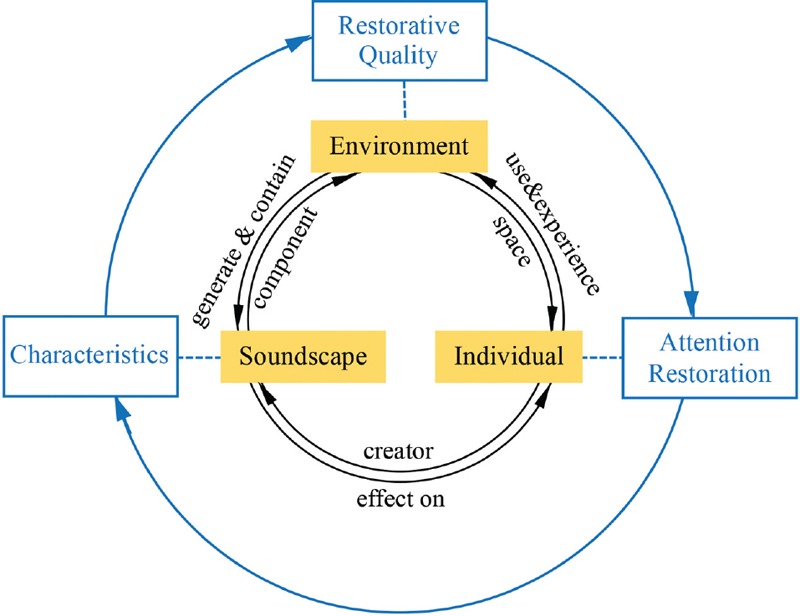
Analysis model of the effect of soundscape on the environmental restoration
Hypotheses
On the basis of the theoretical analysis section, the following hypotheses were established: (1) For individuals in the state of attention fatigue, their directed attention capacity will be restored to a certain extent after they have been resting and relaxing for a period of time in urban natural environments, which can be tested by taking the improvement of an individuals’ attention level as an indicator in the field experiment. (2) In urban natural environments, the different soundscape components present will have distinct effects on the environmental restoration: natural sounds will boost the restoration of the individuals’ attention, whereas traffic and machine sounds will have a negative effect.
The rationale for sound type selection in this study is as follows:
-
(1)
Traffic sounds. Traffic sounds are the most common sounds occurring in urban open space, as found during an investigation in Shenyang city.[39] These types of typical artificial sounds that people often come across in their daily lives are generally least preferred by people.[20,33] Therefore, traffic sounds are selected as the first type of sound in this study.
-
(2)
Machine sounds. Machine sounds are also a common artificial sound in urban environments from different sound sources,[24] and tend to be annoying and disturbing.[48] The main sources of machine sounds include building construction, road maintenance and outdoor air conditioners. In this experiment, because the location of this study was a park with grass mowing, the sound of a mower was chosen as the second type of sound.
-
(3)
Natural sounds. Studies showed that natural sounds (birds, water, etc.) in environments granted people comfort and pleasure, and, therefore, tended to be preferred.[26,29,48] Preferred environments are associated with restorative environments.[49,50,51] According to the analysis of the environment of the experiment site, the sounds of birds and insects are considered the third type of sound.
Experimental design
The experiments were conducted in an urban natural environment, the ribbon-like park zone that is approximately from 500 to 1000 m east of Changqing Bridge and south of Hunhe River in a typical high-density urban setting in Shenyang, China [Figure 2]. This land is composed of woods and grassland that are approximately 150–190 m deep, and Pedestrian Path, Binshui Road, is located between the northern boundary and Hunhe River. The 150 m long Changqing Bridge is located west of the experimental site, and it is a bi-directional, eight-lane road. Nandi E Road to the south is a bi-directional, two-lane road. In addition to the sound of birds and insects, these roadways provide traffic sounds for the experiments. The experimental site was divided into the following three environmental zones: A, B and C, which have same visual elements and the different soundscape component [Figure 2 and Table 1]. Zone A is closest to Changqing Bridge and used as the control of traffic sounds; zone B includes the machine sound of a grass mower as the variable and zone C has the quietest natural environment, with the sound of birds and insects clearly audible.
Figure 2.
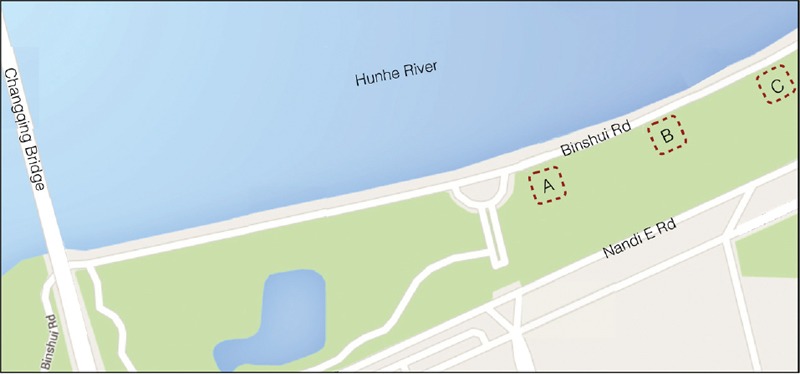
Experimental site and zones of grouping
Table 1.
Environmental characteristics in each experimental zone
| Zone | Main sound source | Equivalent sound level (dBA) | Visual environment |
|---|---|---|---|
| A | Continuous transportation sound, faint bird sound | 55.9 | River, trees, grassland, pedestrian path, overlooking bridge |
| B | Mowing sound (periodic pause), occasional transportation sound | 71.4 | |
| C | Bird sound, insect sound, occasional transportation sound | 47.3 |
The between-participants experimental design method was adopted to avoid interference from practice effect and fatigue effect. The participants were, therefore, divided into four groups according to the experimental hypotheses. The groups included traffic sounds group (A), machine sounds group (B), natural sounds group (C) and no-restoration group (D). The 72 participants included 36 males and 36 females, who were publically recruited volunteers and were all students at Shenyang Jianzhu University, China. To avoid interference from unrelated variables, the groupings were based on matching method. The dimensions for the matching included the following two characteristics: the participants’ gender and their grade in a recent standardised test. Two male students did not complete the experiments. Accordingly, the results of the 70 participants were used for the statistical analysis. Eight student volunteers acted as organisers to assist the researchers in controlling the experimental process. They were trained in advance and asked to organise the participants of each group with a strict schedule.
The participants’ attention levels were measured with a ‘complement test’, in which they were asked to identify pairs of adjacent numbers that add up to 10 in 50 strings of numbers. The participants’ attention levels were graded according to how many complementary pairs they found within 4 min (100-point scale).
Experimental process
The experiments were performed according to the flow as shown in [Figure 3]. First, all the participants were arranged in the same zone, that is, a semi-circular plaza, and were asked to participate in the same fatiguing mental activities that exhausted their capacity for directed attention. In this ‘consumption’ stage, the participants completed a reasoning test of 50 min, which included 50 items that required a high degree of directed attention. A pre-test was performed in the experiment design stage, which proved that the complexity of the test and the number of items were sufficient to lead to a fatigue stage of the participants’ directed attention. Following that, the first attention level test (L 1) was conducted immediately. The score of L 1 represents the level of the individual’ attention level in the fatigue state. The participants in Groups A, B and C were then transported to separate zones for restorative activities within 5 min of walking distance, whereas the participants in Group D (no-restoration group) entered the second attention level test (L 2) after a 5-min-break. Groups A, B and C enjoyed free restorative activities within their respective assigned area. To avoid interference from activities unrelated to this study, the participants were asked to turn off their cell phones, not to talk much and not to sleep. According to Hartig’s[14] finding, the environmental restorative experience should last 30–50 min; thus, the restorative stage lasted 40 min in this experiment. Upon completion of the restorative period, the second attention level test (L 2) was performed on the participants in Groups A, B and C.
Figure 3.
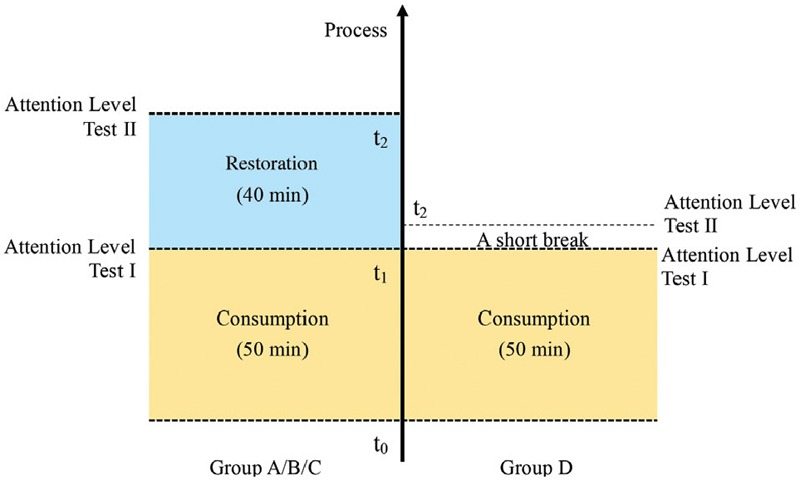
Experimental flow chart
In this experiment, the zone for Group A was the nearest from Changqing Bridge. In addition to the traffic sounds from the traffic on the bridge, traffic sounds from speakers were introduced to enhance the interference variable. Two speakers were hidden in the grass before the experiment so that psychological interference was not introduced. The sounds emitted from the speakers were traffic sounds from the peak morning hours at the crossing of Nanjing S Street and S 3rd Road in Shenyang. Additionally, there were also occasional traffic sounds from Nandi E Road. Only faint bird sounds could be heard in this zone. After the experiment, a random interview with six participants of Group A confirmed that the participants were not aware of the speakers or the introduction of additional traffic sounds.
The interference sound that was introduced to Group B was the sound from a grass mower operating in the field, and there were periodic pauses in this sound. In addition, occasional traffic sounds from Nandi E Road could also be heard. In the intermission when the mower stopped, the sound of birds could be heard, and the environment appeared extremely quiet. The noise of the mower is caused by the exhaust gas pulsation of the engine and the rotation of the blades, mainly in the low-frequency range below 600 Hz, with peak values near 116 and 232 Hz.
The environment of Group C with original soundscape was relatively quiet, in which natural sounds including the sounds of birds and insects could be clearly heard; occasionally, traffic noise from Nandi E Road could also be heard. The environments of these three groups and sound levels measured and recorded by experimenters are summarised in Table 1. The sound levels listed in Table 1 are the average equivalent sound pressure level (Leq) values of the 4 grid points of each zone. Equivalent sound level values were measured in the restorative stage of the experimental process by the integral sound level meters at a height of 120 cm. The sound level was noted every 5 s in one location for 5 min.
The field observation showed that the main activities for each group were walking, sitting and sight viewing [Figure 4a and b]. The participants in Group A did not exhibit a particular awareness of the artificial traffic sounds, and anxiety was not induced by the traffic sounds, although certain individuals showed tiredness. All participants in Group B were aware of the mowing sound and showed certain degrees of anxiety, which was manifested by certain individuals constantly changing the position or posture of their seating. The participants in Group C were the most relaxed compared with the other two groups, and they generally surveyed the surrounding scenes.
Figure 4.
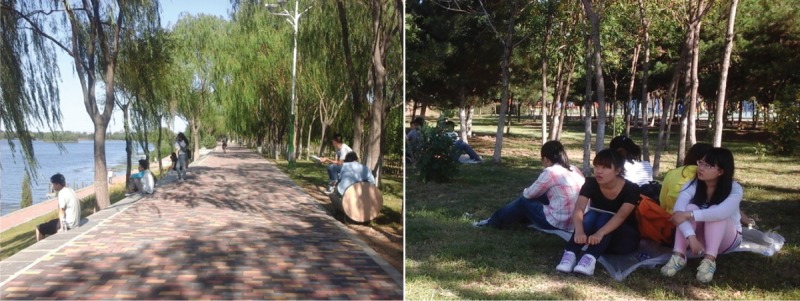
Participants in restorative experience
Results
Description of data
The study focused on whether the participants’ exhausted directed attention could be restored to a certain extent after a period of rest and relaxation, and to what degree this occurred. Therefore, the increase in value between the two attention test results was used as the indicator for analysis, as shown:
ΔL=L2–L1. (1)
By using the data calculation and plotting functionalities in the Statistical Package for the Social Sciences software (SPSS Inc., Chicago, IL, United States), the distributions of the indicator (improvement value) for each group were plotted in boxes [confidence interval of 95%, Figure 5]. The numerical distribution shows that the majority of the tested participants (89.6%) performed better in the second test than in the first. The box plot shows that the numerical distributions are different among each group. The median values indicate that the most obvious improvements were in the natural sounds environment (Group C), and the height of the boxes indicates that the smallest range of changes to attention level were for the participants in the mechanical sounds environment (Group B).
Figure 5.
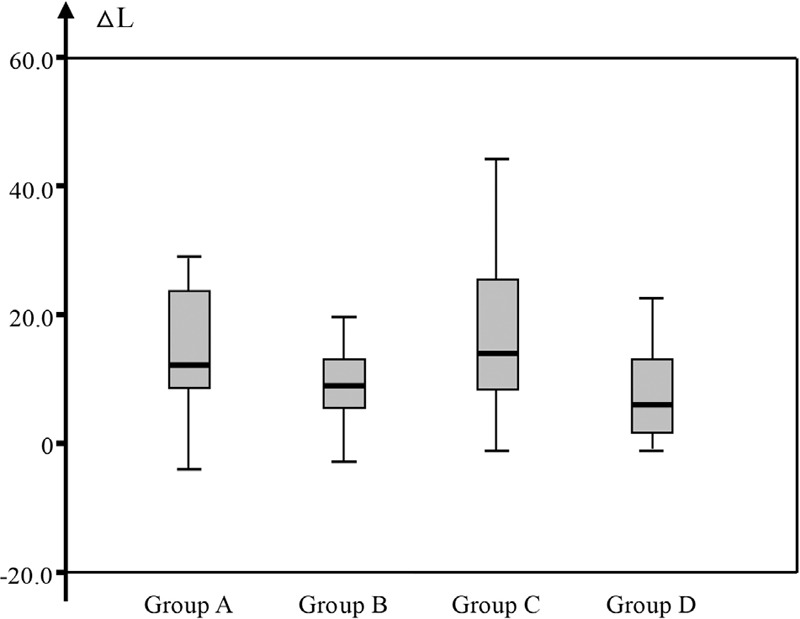
Differences in the grades (ΔL) between the two tests
Because the variables in this study were categorical variables, an analysis of variance was used to determine whether the mean value for each group was statistically significant [Table 2]. The results listed in the table indicate that the mean square values of ‘between groups’ and ‘within groups’ are 347.106 and 106.967, respectively, and the probability that the F value exceeds 3.245 is 0.027 (<0.050), demonstrating that the differences between the mean values for each group are statistically significant and suggesting that the variables, the different sounds present, have significant distinct effects on the restoration of an individual’s attention.On the basis of the analysis of variance results, the mean improvement values between the two attention test results (ΔL = L 2−L 1) for each group were calculated and are shown in Table 3 (confidence interval of 95%).
Table 2.
Analysis of variance (increase of score)
| Sum of squares | df | Mean square | F | Sig. | |
|---|---|---|---|---|---|
| Between groups | 1041.318 | 3 | 347.106 | 3.245 | 0.027 |
| Within groups | 7059.847 | 66 | 106.967 | ||
| Total | 8101.166 | 69 |
Table 3.
Mean (increase of score)
| Groups | Mean | N | Standard deviation |
|---|---|---|---|
| Group A | 11.4 | 17 | 12.7870 |
| Group B | 7.2 | 17 | 7.6027 |
| Group C | 17.4 | 18 | 12.4579 |
| Group D | 9.0 | 18 | 7.1970 |
| Total | 11.3 | 70 | 10.8355 |
Post-hoc comparison showed that the increase between the two attention test results of Group C (i.e. with natural sounds in the environment) was significantly different compared with the result from Group D (without restorative process), sig. = 0.018 (<0.050); there was no significant difference between the values of Group A (with traffic sounds in the environment) and Group D (sig. = 0.241), or Group B (with machine sounds in the environment) and Group D (sig. = 0.610).
Urban natural environmental restorative effects on an individuals’ attention
Group C represents the urban natural environment, and its visual scenes include Hunhe River, trees and grasslands, which are positive environmental elements for attention restoration, as well as some urban settings (road, bridge and path). The core elements of the soundscape are the natural sounds (bird and insect sounds), which have an excellent ability to provide a positive restorative experience.[39] The experimental observations showed that the natural environment was enjoyable and beneficial to the participants, thus could psychologically distance themselves from the fatigue-inducing mental tasks. Natural environmental elements were attractive to the participants. In addition, the relaxing and pleasant feelings inspired by natural environments allow the participant to become more easily immersed in the environment.
It is noted that, when testing the participants’ attention levels with the method of ‘complement test’, the practice effect of the second test could not be completely avoided, although different strings of numbers were used. Thus, for the participants in Groups A, B and C, the improvement in test results must include not only possible restorative effect but also the practice effect, that is,
ΔL=LR+LP, (2)
where L R was the restorative effect and L P was the practice effect for the second test. The participants in Group D did not experience a restorative process and were only allowed a short break before taking the second attention level test. Thus, for Group D, the improvement in test results was solely ascribed to the practice effect of repeating the test, that is ΔL D = L P. Because the grouping was based on matching methods, the improvement value in the two tests for Group D can be viewed as the average of the practice effect for the two tests (L P = 9.0).
When the data in Group C were evaluated according to Eq. (2), the attention test results were improved by an average of 17.4, the practice effect was 9.0 and the restorative effect was 8.4 under the experimental conditions [Figure 6]. These results confirm the positive effect of the urban natural environment in restoring an individual’s attention (Hypothesis 1).
Figure 6.
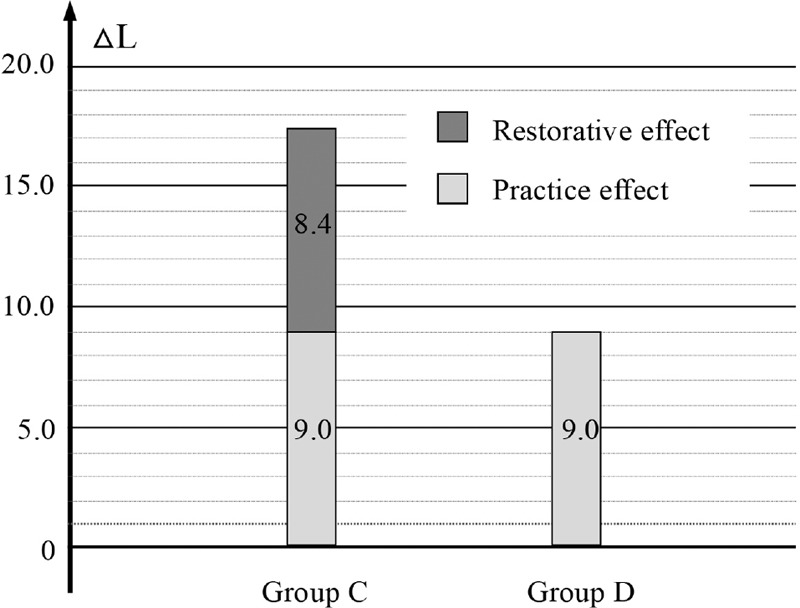
Improvement of grades in the tests of Groups C and D
The effect of the sounds present on the restoration of an individuals’ attention
As the zones A, B and C were in the same environment [Figure 2], the visual landscapes in zones A, B and C were highly similar [Table 1], and the effects of environmental elements contributing to the different sounds in the three groups were isolated. The equation of restorative effect can be obtained in the following manner from Eq. (2), in which L P = 9.0:
LR=ΔL–LP. (3)
The mean values of the restorative effects for these three groups were calculated as shown in Figure 7.
Figure 7.
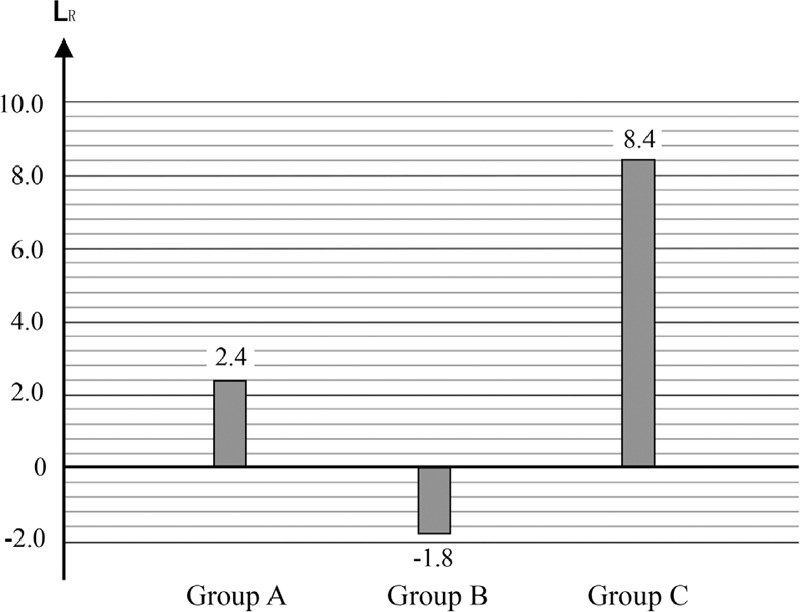
Comparison of the average restorative effect
For Group A in which traffic sounds were introduced and the sound level was 55.9 dBA, no obvious adverse emotions were observed in the participants, suggesting that the participants were accustomed to traffic sounds. The restorative effect for Group A was 2.4, which was 6.0 below that of Group C. Therefore, the participants in Group A did not get effective restoration, from which we can infer that traffic sounds interfere with the individuals’ attention restoration in this zone.
The sound environment in Group B had a much higher sound level, which reached 71.4 dBA because of the mowing sound in this zone. The participants were all aware of this sound source according to the field observation. From the data, the restorative effect was −1.8 (10.2 below that of Group C), which clearly indicated that this unpleasant and loud mechanical sound significantly interfered with the quality of environmental restoration. This zone did not improve the individuals’ attention capacity, and it caused further decreases in attention level.
The natural sounds in Group C were matched with its high-quality visual environment. The main auditory components were the sounds of birds and insects, with occasional traffic sounds. The sound level was 47.1 dBA. These natural sounds enhanced the pleasant mood and produced a positive enhancing effect on the restoration of attention and psychology. In addition, observations have shown that within this kind of soundscape, individuals are more likely to be immersed in the visual experience, thus further enhancing the environmental restoration. The restorative effect in Group C averaged 8.4.
A comparison of the results in Groups A, B and C clearly confirmed the effect of different types of sounds on an individuals’ attention restoration (Hypothesis 2).
Conclusion
In this study, a theoretical investigation of the environmental restoration and a field experiment of an individuals’ attention restoration were combined. These indicate that natural environments indeed have positive effects on the restoration of an individuals’ attention and the contributions of the soundscape to the restoration are as outlined below:
-
(1)
Under the same state of attention fatigue, the participants who were allowed to participate in restorative activities for 40 min in an urban natural environment generated a restorative effect of 8.4 compared with those who did not participate in restoration. This result demonstrates that urban natural environments with natural soundscape have a positive effect on an individual’s restoration of attention.
-
(2)
Despite participating in restorative activities for 40 min continuously in the same assigned environments, the participants who were grouped according to the variable of different soundscapes, including natural sounds environment (47.3 dBA), artificial traffic sounds environment (51.9 dBA) and artificial mowing sound environment (71.4 dBA), had distinctly different restorative effects of 8.4, 2.4 and −1.8, respectively. These results confirm that the sounds present have significant effects on the quality of environmental restoration.
-
(3)
Experimental observations also showed that the sounds in the environments affected an individuals’ capacity to focus on the positive environmental experience, which should further influence the environmental restoration. The different performances of the participants from different groups seemed to show that natural sounds present had enhanced (or allow, at least) individuals to enjoy the positive environmental experience; traffic sounds had not attracted the participants’ much concern, whereas machine sounds had interfered the participants’ environmental experience obviously.
Thus, the findings indicated that different sounds, namely traffic, machine and natural sounds, in urban natural environments, have obvious effects on the quality of environmental restoration. The consideration of soundscape should, therefore, be raised in urban design. Soundscape planning and design can improve the sound quality in cities as well as the environmental restorative quality for urban residents. Further studies are required to investigate other types of soundscape and the effect of the sound levels, frequencies and environmental interconnections on the quality of environmental restoration.
Financial support and sponsorship
This study was made possible by the financial support from the Natural Science Foundation of Liaoning Province, China (Contract No. 2016010634-301).
Conflicts of interest
There are no conflicts of interest.
Acknowledgements
We thank the participants from the School of Management in Shenyang Jianzhu University, China.
REFERENCES
- 1.Hartig T, Staats H. Linking preference for environments with their restorative quality. In: Tress B, Tres G, Fry G, Opdam P, editors. From Landscape Research to Landscape Planning: Aspects of Integration, Education and Application. Dordrecht, Netherlands: Springer; 2005. pp. 279–92. [Google Scholar]
- 2.Kaplan S. A model of person–environment compatibility. Environ Behav. 1983;1:311–32. [Google Scholar]
- 3.Kaplan R, Kaplan S. The Experience of Nature: A Psychological Perspective. New York, NY: Cambridge University Press; 1989. [Google Scholar]
- 4.James W. Psychology: The Briefer Course. New York: Henry Holt; 1982. [Google Scholar]
- 5.Kaplan S. Meditation, restoration and the management of mental fatigue. Environ Behav. 2001;33:480–506. [Google Scholar]
- 6.Kaplan S. The restorative benefits of nature: Toward an integrative framework. J Environ Psychol. 1995;15:169–82. [Google Scholar]
- 7.Hartig T. Restorative environments. In: Spielberger C, Diego S, editors. Encyclopedia of Applied Psychology. CA: Academic Press; 2004. pp. 273–9. [Google Scholar]
- 8.Tennessen CH, Cimprich B. Views to nature: Effects on attention. J Environ Psychol. 1995;15:77–85. [Google Scholar]
- 9.Kaplan R. The nature of the view from home-psychological benefits. Environ Behav. 2001;3:507–42. [Google Scholar]
- 10.Herzog TR, Black AM, Fountaine KA, Knotts DJ. Reflection and attentional recovery as distinctive benefits of restorative environments. J Environ Psychol. 1997;17:165–70. [Google Scholar]
- 11.Ulrich LS, Simons LF, Losito BD, Fiorito E, Miles MA, Zelson M. Stress recovery during exposure to natural and urban environments. J Environ Psychol. 1991;11:201–30. [Google Scholar]
- 12.Hartig T, Mang M, Evans GW. Restorative effects of natural environment experience. Environ Behav. 1991;23:3–26. [Google Scholar]
- 13.Keniger LE, Gaston KJ, Irvine KN, Fuller RA. What are the benefits of interacting with nature? Int J Environ Res Public Health. 2013;10:913–35. doi: 10.3390/ijerph10030913. [DOI] [PMC free article] [PubMed] [Google Scholar]
- 14.Hartig T. Three steps to understanding restorative environments as health resources. In: Ward TC, Travlou P, editors. Open Space: People Space. Abingdon: Taylor & Francis; 2007. pp. 163–80. [Google Scholar]
- 15.Zhang Y, Kang J, Jin H. Study on restorative benefits of public open space in high-density city: Take Shenyang as an example. Archit J. 2015;13:152–7. [Google Scholar]
- 16.Granö JG. Pure Geography. Baltimore and London: The Johns Hopkins University Press; 1997. [Google Scholar]
- 17.International Organization for Standardization. ISO 12913-1: Acoustics-Soundscape − Part 1: Definition and Conceptual Framework. 2014. [Google Scholar]
- 18.Truax B. Handbook for Acoustic Ecology. Cambridge Street Publishing; 1999. [CD-ROM version] [Google Scholar]
- 19.Kang J. Soundscape: Current progress and future development. New Archit. 2014;156:4–7. [Google Scholar]
- 20.Kang J. Urban Sound Environment. London: Taylor & Francis Incorporating Spon; 2006. [Google Scholar]
- 21.Brown AL, Muhar A. An approach to the acoustic design of outdoor space. J Environ Plan Manage. 2004;47:827–42. [Google Scholar]
- 22.Jeon JY, Lee JP, Hong JY. Non-auditory factors affecting urban soundscape evaluation. Acoust Soc Am. 2011;130:3761–70. doi: 10.1121/1.3652902. [DOI] [PubMed] [Google Scholar]
- 23.Katherine NI, Patrick DW, Sarah RP, Richard AF. Green space, soundscape and urban sustainability: An interdisciplinary empirical study. Local Environ. 2009;14:155–72. [Google Scholar]
- 24.Jabben J, Weber M, Verheijen E. A framework for rating environmental value of urban parks. Sci Total Environ. 2013;508:395–401. doi: 10.1016/j.scitotenv.2014.12.007. [DOI] [PubMed] [Google Scholar]
- 25.Schulte FB, Dubois D. Recent advances in soundscape research − Preface. Acta Acust United Acust. 2006;92:V–VIII. [Google Scholar]
- 26.Yang W, Kang J. Soundscape and sound preferences in urban squares: A case study in Sheffield. J Urban Des. 2005;10:61–80. [Google Scholar]
- 27.Bento Coelho JL, Boubezari M. On the soundscape of urban parks. J Acoust Soc Am. 2011;130:2531. [Google Scholar]
- 28.You J, Lee PJ, Jeon JY. Evaluating water sounds to improve the soundscape of urban areas affected by traffic noise. Noise Control Eng J. 2010;58:477–83. [Google Scholar]
- 29.Jeon JY, Lee PJ, You J, Kang J. Perceptual assessment of quality of urban soundscapes with combined noise sources and water sounds. J Acoust Soc Am. 2010;127:1357–66. doi: 10.1121/1.3298437. [DOI] [PubMed] [Google Scholar]
- 30.Yang W, Kang J. Acoustic comfort evaluation in urban open public spaces. Appl Acoust. 2005;66:211–29. [Google Scholar]
- 31.Yu CJ, Kang J. Effects of cultural factors on the evaluation of acoustic quality in residential areas. Australia: ICA2010, Sydney; 2010. [Google Scholar]
- 32.Brambilla G, Gallo V, Zambon G. The soundscape quality in some urban parks in Milan, Italy. Int J Environ Res Public Health. 2013;10:2348–69. doi: 10.3390/ijerph10062348. [DOI] [PMC free article] [PubMed] [Google Scholar]
- 33.Liu J, Kang J, Behm H, Luo T. Effects of landscape on soundscape perception: Soundwalks in city parks. Landsc Urban Plan. 2014;123:30–40. [Google Scholar]
- 34.Klaeboe R, Engelien E, Steinnes M. Context sensitive noise impact mapping. Appl Acoust. 2006;67:620–42. [Google Scholar]
- 35.Axelsson Ö. Designing soundscape for sustainable urban development. Stockholm, Sweden: City of Stockholm; 2010. pp. 9–13. [Google Scholar]
- 36.Van Kamp I, Klæboe R, Brown AL, Lercher P. Soundscapes, human restoration and quality of life. In: Kang J, Schulte-Fortkamp B, editors. Soundscape and the Built Environment. Boca Raton: CRC Press; 2015. pp. 89–133. [Google Scholar]
- 37.Payne SR. Are perceived soundscape within urban parks. Acoustics 08 Paris.org; 2008. pp. 5521–6. [Google Scholar]
- 38.Payne SR. The production of a perceived restorativeness soundscape scale. Appl Acoust. 2013;74:255–63. [Google Scholar]
- 39.Zhang Y. Research on soundscape restorative benefits of urban open space and promotion strategy of the acoustic environment quality. New Archit. 2014;165:18–22. [Google Scholar]
- 40.Brown AL, Kang J, Gjestland T. Towards standardization in soundscape preference assessment. Appl Acoust. 2011;72:387–92. [Google Scholar]
- 41.Norberg-Schulz C. Genius Loci − Towards a Phenomenology of Architecture. New York: Rizzoli International Publications; 1980. [Google Scholar]
- 42.Raimbault M, Bengier BM, Dubois D. Common factors in the identification of urban soundscapes pilot study in two French cities: Lyon and Nantes. Proceedings of the 17th International Congress on Acoustics, Rome, Italy. 2001. [Google Scholar]
- 43.Kang J, Yang W. Soundscape in urban open public spaces. World Archit. 2002;144:76–9. [Google Scholar]
- 44.Herranz-Pascual K, Aspuru I, Garcia I. Proposed conceptual model of environmental experience as framework to study the soundscape. Inter-Noise, Lisbon; 2010. [Google Scholar]
- 45.Kihlman T, Kropp W, Hrstr ME, Berglund B. Soundscape support to health-a cross-disciplinary research program. The Netherlands: Proceedings of Inter-Noise, Hague; 2010. [Google Scholar]
- 46.Lercher P, Widmann U. Mental health and a complex sound environment in an Alpine valley: A case study. Rome, Italy: Proceedings of the 17th International Congress on Acoustics (ICA); 2001. [Google Scholar]
- 47.Zhang Y, Kang J, Jin H. An experimental study on the restorative experience of typical urban soundscape based on EDA. Italy: iiav.org; 2015. [Google Scholar]
- 48.Kang J, Zhang M. Semantic differential analysis of the soundscape in urban open public spaces. Build Environ. 2010;45:150–7. [Google Scholar]
- 49.Purcell T, Peron E, Berto R. Why do preferences differ between scene types? Environ Behav. 2001;33:93–106. [Google Scholar]
- 50.Korpela KM, Hartig T, Kaiser FG, Fuhrer U. Restorative experience and self-regulation in favorite places. Environ Behav. 2001;33:572–89. [Google Scholar]
- 51.Van den Berg AE, Kooole SL, Van den Wulp NY. Environmental preference and restoration: How are they related. J Environ Psychol. 2003;23:135–46. [Google Scholar]


